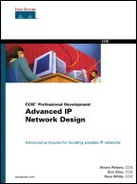Case Study: Dial Backup with a Single Router
While BGP is capable of conditional advertisement, most other routing protocols aren't. You need to find a way to advertise backup links only under certain conditions, particularly if they are dial-on-demand, such as ISDN.
Figure 3-17 depicts a common scenario; Router B has a point-to-point link through Serial 0 to Router A, and a dial-on-demand backup link through BRI 0 to Router C. The routing protocol is EIGRP, and Router B is only receiving 0.0.0.0/0 advertised from Router A (the default route). The network administrator doesn't want the ISDN link up unless the serial link fails.
Figure 3-17. ISDN Dial-on-Demand

There are two possibilities for bringing the ISDN dial-on-demand link up when the serial interface fails:
Configuring the ISDN link as a backup interface. Configuring an interface as a backup, as the name implies, instructs the router to bring a dial interface up in response to another interface's line state changing to down.
Using a combination of floating static routes and a dynamic routing protocol to redirect traffic over the ISDN link.
It's relatively simple to configure the ISDN interface as a backup interface for Serial 0 in Figure 3-17. On Router B:
isdn switch-type basic-ni1
!
interface BRI0
ip address 172.16.10.33 255.255.255.252
encapsulation ppp
no ip route-cache
no ip mroute-cache
bandwidth 128
dialer idle-timeout 600
dialer map ip 172.16.10.34 name C 5551212
dialer-group 1
isdn spid1 91955588880100
isdn spid2 91955588880100
no fair-queue
no cdp enable
ppp authentication chap
ppp multilink
!
interface Serial 0
ip address 172.16.10.29 255.255.255.252
encapsulation frame-relay
backup interface bri 0
backup delay 10 120
!
router eigrp 1
network 172.16.0.0
!
ip classless
access-list 101 deny eigrp any any
access-list 101 permit ip any any
dialer-list 1 protocol ip list 101
Configuring the ISDN link as a backup interface relies on the serial interface actually going down to trigger the switch from the serial link. Unfortunately, the condition of the interface doesn't necessarily reflect the condition of Layer 3 connectivity, particularly for Frame Relay networks.
When the physical layer can't be used to indicate IP connectivity across a link, it's better to use routing to bring the backup link into operation—a job for floating static routes. The configuration follows:
isdn switch-type basic-ni1
!
interface BRI0
ip address 172.16.10.33 255.255.255.252
encapsulation ppp
no ip route-cache
no ip mroute-cache
bandwidth 128
dialer idle-timeout 600
dialer map ip 172.16.10.34 name C 5551212
dialer-group 1
isdn spid1 91955588880100
isdn spid2 91955588880100
no fair-queue
no cdp enable
ppp authentication chap
ppp multilink
!
interface Serial 0
ip address 172.16.10.29 255.255.255.252
encapsulation frame-relay
!
ip route 0.0.0.0 0.0.0.0 172.16.10.34 200
access-list 101 deny eigrp any any
access-list 101 permit ip any any
dialer-list 1 protocol ip list 101
The number at the end of the IP route command indicates an administrative distance. Because Router C would normally have a 0.0.0.0/0 route from Router A through EIGRP, this static route will not normally be used (placed in the routing table). If Router A were lost as an EIGRP neighbor, though, Router C would begin using this static, which points out through the ISDN link.
Once interesting traffic begins to be forwarded out of interface BRI 0 (as defined by dialer-list 1), the router will begin the ISDN link up. Once the serial link is restored, the 0.0.0.0/0 route learned through EIGRP from Router A should once again be installed in the routing table, and all traffic should be forwarded through the serial interface.
Because EIGRP is not considered interesting traffic, the router will eventually bring the ISDN link down.
Note that in both of these configurations, IP route-cache is disabled on the ISDN interface. It's important that the router not cache any destinations as reachable through the ISDN interface because it will continue sending traffic for those destinations through the ISDN interface, regardless of the state of the serial interface, until the route cache entry times out.
